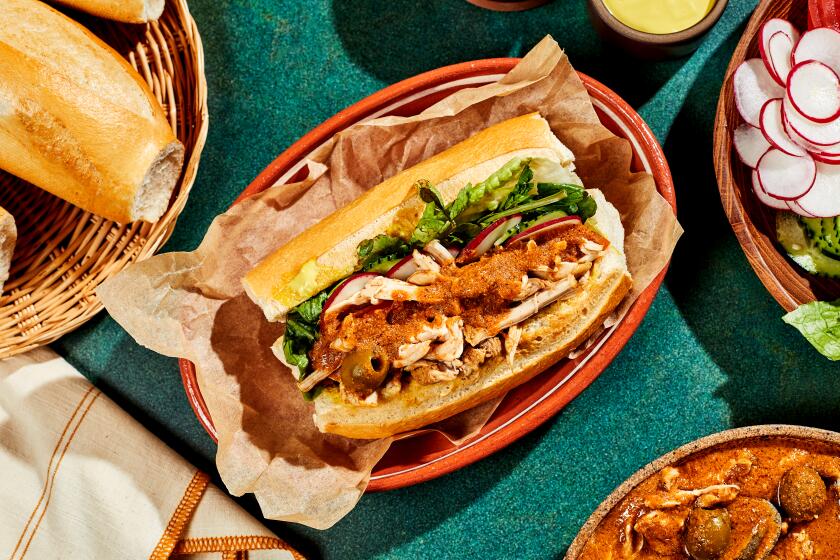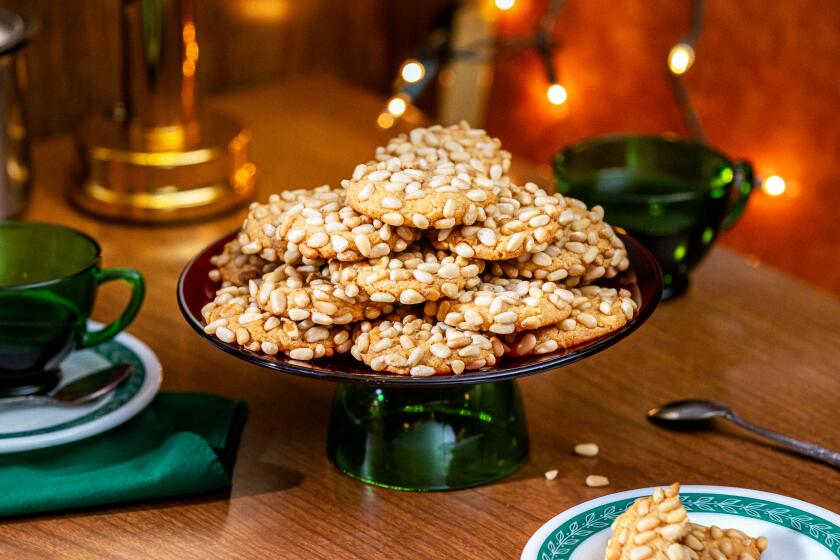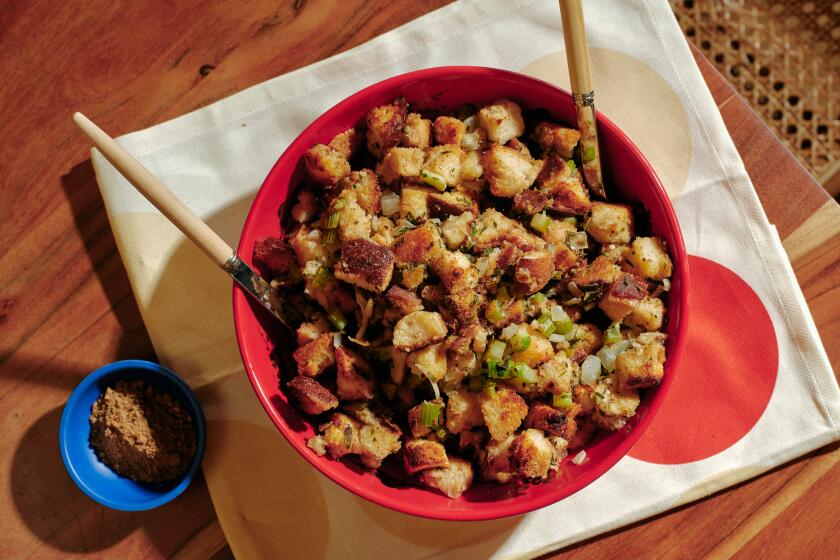Focaccia from Genoa
When a television series has devolved so far from its original premise that it reaches a kind of nonsensical absurdity, we say it has jumped the shark. Thatâs usually a good time to go back and take a fresh look at what made the original work so well. The culinary equivalent might be something getting used in a fast-food sandwich. And so itâs time to get back to basics with focaccia.
I ordered a sandwich at my local lunch counter the other day and the guy asked me what kind of bread I wanted: âWhite, whole wheat or focaccia,â the latter a flattish white bread topped with what appeared to be sliced tomatoes, onions, cheese and lord knows what else.
In going public with these kinds of complaints, thereâs always a danger of coming off all Andy Rooney-ish. Iâm neither that old nor that perturbed. So Iâm going to take the high road, praising true focaccia without stooping to condemn âfocaccia bread.â Iâll leave it up to you to decide which you prefer. I know youâll do the right thing.
Real focaccia is a lot closer to pizza than it is to anything that could be used to make a sandwich. In fact, if you imagine a slightly thicker, crisp-crusted, rectangular pizza with very restrained toppings, youâre just about there.
But though pizza can stand in for a meal, focaccia is more of a snack, or at most an appetizer. In Italy, itâs a popular walking-around food.
Also, though cold pizza may have a certain raffish charm, focaccia really needs to be eaten when itâs hot to be at its best. It goes stale very quickly. Though Iâm enjoying the slice of focaccia topped with Gorgonzola that Iâm eating for lunch while writing this, in no way is it nearly as good as it was last night right out of the oven.
Then, I served it with Champagne to start a dinner party. Served warm, the crust was crisp while the interior, rich with olive oil, was tender. The cheese had melted and browned, and the flavor was much more mellow than you might expect from a blue. The whole thing was deeply savory and made a perfect foil served alongside radishes from the garden and some thinly sliced dried sausage.
It was also really easy to make because, thanks to a couple of weeks of focaccia experiments, I had a blob of already-made dough sitting in the freezer. After defrosting, I just stretched it into a well-oiled jellyroll pan (a generous hand with the olive oil gives a crisper crust), then scattered a half pound of crumbled Gorgonzola on top and baked it. That was all there was to it.
Donât complicate it
Most focaccias arenât any more complicated than that, because the toppings tend to the austere: thinly sliced onions drizzled with olive oil, pitted olives, cubed pancetta with a scattering of rosemary leaves. To complicate a focaccia topping is to misunderstand its elemental appeal.
But donât mistake simplicity for lack of flavor. My favorite focaccia is topped with nothing more than good olive oil and coarse salt. Made the Genovese way -- with plenty of olive oil and white wine in the crust -- itâs so delicious I could eat it all day.
Of the half-dozen recipes I tried, my favorite comes from Carol Field. For those of you who love Italian cooking, that probably will come as no surprise, as her âThe Italian Baker,â published more than 25 years ago, is still the definitive book on Italian breads.
This recipe is from a small book she did 15 years ago called simply âFocaccia.â The doughâs easy to make and very silky to work with. Even better, unlike many focaccia recipes, it doesnât require an overnight rise, so you can knock it together with a minimum of forethought -- always a plus at my house, where meal planning tends to go on an hour-by-hour basis.
Ornamenting this focaccia with a topping of some sort would obscure its main pleasures: the crunchy crust and the pure flavors of olive oil, wheat and salt. For focaccia that will be topped, I prefer a plainer dough, such as the one Peter Reinhart includes in his ode to pizza, âAmerican Pie.â
Whereas Fieldâs book is based in the first wave of artisanal home bread baking, Reinhartâs is right up to the cutting edge. His focaccia is based on one of those âretardedâ doughs -- refrigerated overnight to slow the fermentation and allow a longer period of enzymatic action, resulting in more complex flavors. He also uses a minimum of handling to keep from deflating the dough. And stylistically his focaccia is thicker and âbreadierâ than Fieldâs.
Focaccia doughs in general tend to be fairly fluid -- particularly if youâre used to making heartier breads. Bread bakers talk about percentage of hydration -- the ratio of water to flour. If you have 10 ounces of flour (about 2 cups) and add 6 ounces of water (weight, not volume -- about three-quarters cup), youâll have 60% hydration. Though most bread doughs are around 60%, focaccias generally run 70% and higher. I even tested one that was more than 100%.
Secret to crispness
Doughs this wet feel almost like batters, but that is the secret to focacciaâs delicious crispness. It also facilitates the shaping. If youâve struggled stretching out perfect pizza rounds, focaccia will be a welcome relief. Essentially, all you do is spread the dough into a jellyroll pan. If it doesnât fit perfectly at first, just set it aside for a couple of minutes to let the dough rest and it shouldnât give you any more trouble.
After itâs stretched, dimple the dough by lightly tapping it all over with your fingertips. Remember, youâre dimpling, not indenting, and certainly not piercing. After a second rise, dimple again and youâre ready to top and bake.
There are a couple of other things that help make a crisper crust. Bake the focaccia on a pizza stone set on a rack in the middle of the oven. And slide a pan of water onto the floor of the oven to help with crispness and improve âoven springâ -- that final rise that happens after the bread starts to bake.
The bread is done when it is well-browned on top and on the bottom. If you oiled the pan sufficiently, you should be able to use a spatula to lift a corner of the bread to see. Let it cool for just a couple of minutes, and then cut it into slabs.
Just out of the oven, the crust gives off a warm fragrance of good olive oil. It crunches lightly when you bite into it, but the interior is still tender and just chewy enough to be interesting. The salt adds a sharp contrast.
Eat it as a snack, serve it as an appetizer, however you like. But if you turn it into a sandwich, I donât want to know about it.
Sponge
Sprinkle the yeast over the warm water in a large mixing bowl, stir it in and set aside until creamy, about 10 minutes. Stir in the flour and beat until smooth. Cover tightly with plastic wrap and set aside to rise until puffy and bubbling, about 30 minutes.
Dough and assembly
To the sponge in the large bowl, add the water, wine and one-third cup olive oil, and stir to combine.
If mixing by hand, whisk in 1 cup of flour and 2 teaspoons salt, then beat in the rest of the flour until you have a dough that is very soft and very sticky. Knead on a lightly floured board with the help of a dough scraper and 1 to 2 additional tablespoons of flour until the dough comes together nicely and is silky and shiny, 6 to 8 minutes; it should remain soft but not wet.
If mixing with a mixer, using the paddle attachment beat together the water, wine, one-third cup olive oil and sponge. Add the flour and 2 teaspoons salt and mix until the dough comes together (it will be very soft). Change to the dough hook and knead for 3 minutes at medium speed, stopping once or twice to press the dough into a ball to aid in the kneading. Remove the dough from the bowl and knead by hand using the 1 to 2 additional tablespoons of flour to finish, 6 to 8 turns at most. It should remain soft but not wet.
Place the dough in a large, lightly oiled container, cover it tightly with plastic wrap, and set aside until doubled, about 1 hour.
The dough should be soft and full of air bubbles and should stretch easily. Press it into a well-oiled (17-by-12-inch) jelly roll pan, dimple it well with your fingertips or knuckles, cover with a towel and let rise until puffy and doubled, about 45 minutes. If the dough springs back before it is completely stretched, set it aside to ârelaxâ the dough for a few minutes, then stretch again; the dough will stretch more easily after it is rested.
At least 30 minutes before you plan to bake, heat the oven to 425 degrees with a baking stone inside on the lowest shelf. Once again, dimple the top of the dough with your fingertips or knuckles, drizzle the remaining 2 tablespoons of olive oil so it pools in the little indentations and sprinkle with the remaining salt.
Place the pan directly on the stone and immediately reduce the temperature to 400 degrees. Place a shallow metal container of water on the floor of the oven to make steam.
Bake until the focaccia is golden (lift the bread to check underneath as well), 25 to 30 minutes. Immediately remove from the oven and cool briefly on a rack. Serve warm or at room temperature.
Get our Cooking newsletter.
Your roundup of inspiring recipes and kitchen tricks.
You may occasionally receive promotional content from the Los Angeles Times.
















